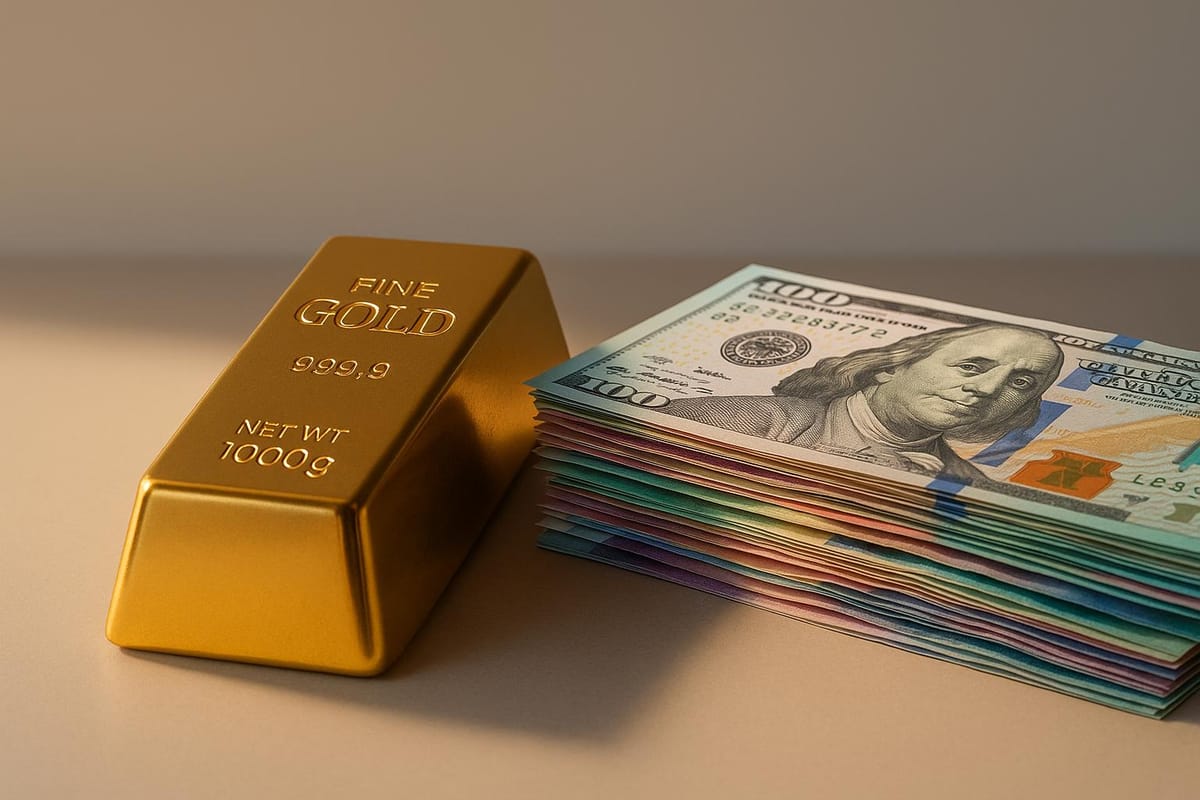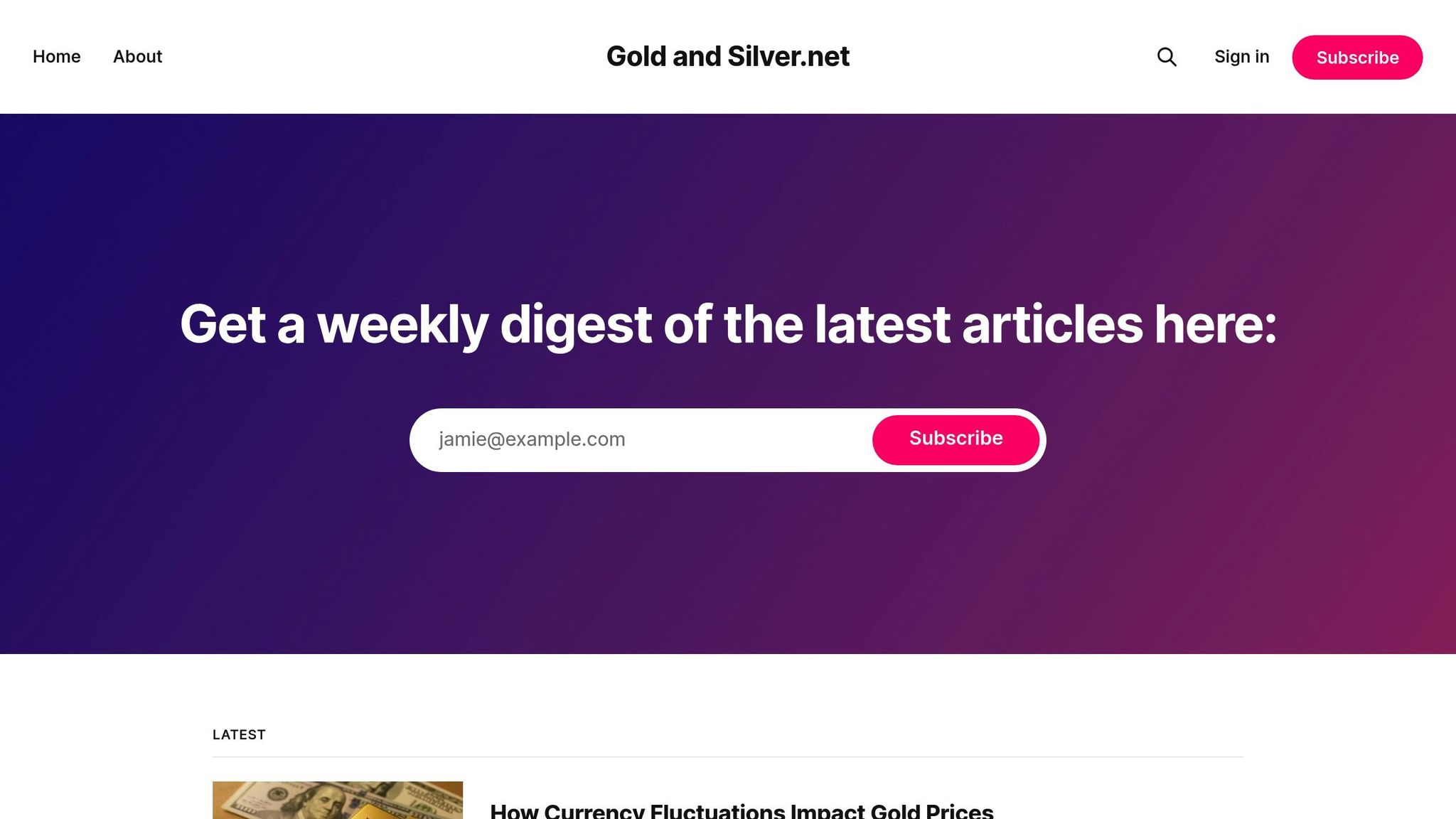Gold vs Currency: Hedging Strategies Compared
Explore the differences between gold and currency hedging strategies to protect your investments from currency risks and inflation.

When it comes to protecting your investments from currency risks, two common strategies stand out: gold and currency hedging tools. Each offers unique advantages depending on your goals and timeframe:
- Gold: A long-term safeguard against inflation and monetary instability. It's simple to use, holds value over time, and provides a broad hedge against economic uncertainty.
- Currency Hedging: A precise, short-term solution for managing specific exchange rate risks. Tools like forwards, options, and ETFs help lock in rates or reduce volatility but require active management and come with variable costs.
Key Takeaways:
- Gold is a reliable long-term store of value but lacks precision for short-term currency fluctuations.
- Currency hedging is ideal for short-term needs but can be complex and costly to maintain.
- Many investors combine both strategies for balanced protection: gold for stability and hedging tools for targeted risks.
Quick Comparison:
| Aspect | Gold | Currency Hedging |
|---|---|---|
| Protection Focus | Broad economic instability | Specific exchange rate movements |
| Time Horizon | Long-term | Short- to medium-term |
| Cost | Predictable (storage/ETF fees) | Variable (premiums, spreads, rebalancing) |
| Complexity | Low – buy and hold | Medium to high – active management needed |
| Inflation Coverage | Strong | Limited |
The Bottom Line: Choose gold for simplicity and long-term stability. Use currency hedging for precise, short-term currency risk management. A mix of both can give your portfolio broader protection.
Currency Risk - Should You Hedge?
Gold as a Currency Risk Hedge
Gold serves as a hedge against currency risks by maintaining its inherent value, even when traditional currencies face challenges. Unlike paper money, which can be influenced by government policies, gold holds its worth independently. When the U.S. dollar weakens due to factors like inflation, excessive money printing, or economic instability, gold often steps in to help preserve purchasing power.
This precious metal is widely accepted and trades globally, making it a go-to safe haven asset during turbulent times in currency markets. Investors often turn to gold when currencies falter, driving its price higher while currency values dip. This inverse relationship can act as a stabilizer for portfolios during periods of volatility.
Gold's Track Record During Currency Volatility
Gold has repeatedly proven its value during times of currency instability. In the 1970s, for example, the U.S. faced stagflation - a toxic mix of high inflation and economic stagnation. During this period, the dollar’s purchasing power plummeted, but gold prices soared. From $35 per ounce in 1971, gold skyrocketed to over $850 per ounce by January 1980, reflecting an astonishing gain of more than 2,300%.
The 2008 financial crisis offered another striking example. As the Federal Reserve introduced quantitative easing programs, weakening the dollar, gold surged from approximately $800 per ounce in late 2008 to over $1,900 per ounce by September 2011. That’s a 137% increase, even as the U.S. Dollar Index dropped by 17%.
Fast forward to the COVID-19 pandemic, and gold once again demonstrated its hedging power. In March 2020, the Federal Reserve slashed interest rates and rolled out massive stimulus measures. Gold responded by climbing from $1,500 per ounce to a record $2,067 per ounce by August 2020 - a 38% rise that coincided with fears of currency debasement due to unprecedented monetary expansion.
These cases highlight gold’s ability to protect against currency risks, offering investors a reliable hedge.
Benefits of Gold Hedging
Gold provides several advantages as a currency hedge, making it an appealing choice for U.S. investors. One key factor is its physical scarcity, which ensures that it cannot be artificially expanded like fiat currencies. This scarcity has allowed gold to maintain its purchasing power over centuries, making it a dependable store of value.
Another advantage is gold's 24/7 liquidity. It trades continuously across global markets, allowing investors to access its hedging benefits at any time. This constant price discovery sets it apart from other currency hedging tools, which may have restricted trading hours or rely on specific market conditions.
Gold also offers inflation protection. While currency hedges guard against exchange rate fluctuations, they don’t address the loss of purchasing power caused by inflation. Gold, on the other hand, tends to rise alongside inflation, helping investors preserve their real wealth during periods of rising prices.
Finally, gold’s simplicity and permanence make it accessible to a wide range of investors. Unlike complex currency derivatives that require active management or expire, physical gold or gold-backed securities can be held indefinitely without the need for maintenance. This makes it an easy-to-understand option for those who may not have the expertise to navigate more sophisticated hedging strategies.
Drawbacks of Gold Hedging
Despite its strengths, gold hedging comes with its own set of challenges. One major drawback is price volatility. While gold often moves inversely to currency values, its price can experience sharp swings that don’t always align with currency trends. For instance, in 2013, gold prices fell by 28%, even as concerns about dollar weakness persisted.
Another issue is the cost of storage and insurance. Physical gold needs to be stored securely and insured, which can add annual expenses ranging from 0.5% to 2%. Even gold ETFs, which eliminate the need for physical storage, come with management fees that can erode returns over time.
Gold also lacks income generation. Unlike dividend-paying stocks or interest-bearing bonds, gold doesn’t produce cash flow. This can drag down portfolio returns during periods of currency stability, when the hedging benefits of gold are less critical.
Timing can also be a challenge. Gold’s response to currency weakness is not always immediate or consistent. For example, during 2014-2015, the dollar strengthened significantly, but gold’s decline was less pronounced than expected. Similarly, in 2016-2017, gold remained relatively stable even as the dollar continued to gain strength. These inconsistent correlations mean that gold may not always provide protection precisely when it’s needed most.
Next, we’ll explore alternative tools for currency hedging and how they compare to gold's performance.
Currency Hedging Methods
Currency hedging provides a focused way to manage exchange rate risks, offering a more targeted approach than the broader protection associated with gold. These tools are designed to offset potential losses from unfavorable currency movements, enabling investors to address specific risks tied to exchange rates.
While gold is traditionally seen as a general store of value, currency hedging tools are all about precision. They lock in future rates or act as insurance against adverse shifts, giving investors more control over the outcomes of their international investments.
Currency Hedging Tools
There are several tools available for currency hedging, each with its own strengths:
- Foreign exchange forwards: These contracts allow investors to lock in exchange rates for future transactions, reducing uncertainty about currency values down the line.
- Currency futures: Similar to forwards, these are traded on organized exchanges, offering greater liquidity and standardized terms.
- Currency options: These provide flexibility by giving investors the right - but not the obligation - to exchange currencies at a predetermined rate. This means investors can benefit from favorable market movements while being shielded from adverse ones.
- Currency-hedged ETFs: These funds are a convenient option for retail investors, allowing access to international markets without taking on currency risk.
Costs and Practical Considerations
Hedging comes with costs. These include bid-ask spreads, interest rate differences in forward contracts, and premiums for options. Additionally, active management and periodic rebalancing are often required, which can increase transaction expenses.
For simplicity, many individual investors turn to currency-hedged funds. While these funds streamline the process, they come with management fees that should be factored into the overall cost.
When Currency Hedging Makes Sense
Currency hedging is especially useful during times of high exchange rate volatility or when investors have a strong short-term outlook on currency movements. It’s particularly advantageous for short-term investments, as there’s less time for currency fluctuations to even out.
This strategy is also appealing to investors who want to isolate specific risks. For example, if someone is optimistic about foreign equities but worried about currency depreciation, hedging can help them capture the potential equity gains while minimizing currency exposure.
On the flip side, during periods of low volatility or when hedging costs are high, an unhedged position may be the better choice - especially for long-term investments. This targeted approach to managing currency risk sets the stage for a deeper comparison with gold hedging in the next section.
Gold vs Currency Hedging Comparison
Following our earlier analysis, let's dive into a direct comparison of gold and currency hedging. Both strategies have their own strengths and challenges, and the right choice depends heavily on your investment goals and how you view the market.
How Each Strategy Handles Currency Risk
Gold and currency hedging tackle exchange rate risks in very different ways. Gold acts as a broad safeguard, often gaining value when currencies falter - especially during times of economic uncertainty or rising inflation. Its reliability as a hedge comes from its long history as an alternative store of value when confidence in fiat currencies wanes.
Gold tends to perform well during inflationary times. When monetary policies lead to significant currency expansion, gold prices often rise in local currency terms. This makes it a strong choice for guarding against long-term currency devaluation. However, it’s less effective for short-term fluctuations in exchange rates.
Currency hedging tools, on the other hand, are designed for precision. They lock in specific rates or provide flexible protection against downside risks, making them ideal for managing short-term currency volatility. These tools shine when you need to address specific currency movements over defined periods.
The key distinction lies in their scope. Gold offers a buffer against broader monetary instability, while currency derivatives focus on particular exchange rate changes. While gold doesn’t always align perfectly with daily currency shifts, currency hedging tools are built to target those exact movements.
Beyond risk management, factors like cost, complexity, and ease of use further separate these two approaches.
Costs, Complexity, and Ease of Use
The costs tied to these strategies are quite different. Gold hedging generally involves predictable and transparent expenses, such as storage or management fees.
Currency hedging, however, can be more complicated. Forward contracts come with interest rate differentials, options require upfront premiums, and active strategies demand frequent rebalancing. Costs can vary widely based on factors like market conditions, expiration dates, and the currencies involved.
When it comes to complexity, gold hedging is relatively simple. You can buy physical gold or gold-backed securities and hold onto them - no expiration dates, strike prices, or contract rollovers to worry about.
Currency hedging, by contrast, requires active management. Forward and futures contracts have expiration dates that need renewing, and options strategies involve decisions about strike prices and timing. Even currency-hedged ETFs, while easier for individual investors, still require ongoing management by fund professionals.
For ease of use, gold has the edge for most retail investors. Buying gold ETFs is as simple as purchasing a stock through a brokerage account. Currency hedging tools, however, often require specialized accounts, higher investment minimums, and a deeper understanding of trading mechanics.
Side-by-Side Comparison
| Aspect | Gold Hedging | Currency Hedging |
|---|---|---|
| Primary Protection | Broad monetary instability, long-term currency weakness | Specific exchange rate movements, short-term volatility |
| Time Horizon | Long-term (years) | Short to medium-term (months to 2 years) |
| Cost Structure | Storage/management fees (0.25%-1% annually) | Premiums, spreads, interest differentials (varies widely) |
| Complexity | Low – buy and hold | Medium to high – active management required |
| Precision | Broad hedge, imperfect correlation | Exact hedge for specific currency pairs |
| Liquidity | High for ETFs, moderate for physical gold | High for major currencies; varies for others |
| Effectiveness in Inflation | Strong historical performance | Limited direct inflation protection |
| Effectiveness in Deflation | May decline with other assets | Can provide targeted protection |
| Minimum Investment | Low (single shares of ETFs) | Often higher, especially for derivatives |
| Regulatory Requirements | Minimal | May require options approval and margin accounts |
These contrasts highlight when each strategy makes sense. Gold is a solid choice for those focused on long-term monetary concerns and currency devaluation, while currency hedging is better suited for managing specific international exposures over shorter periods.
Picking the Right Strategy for U.S. Investors
Choosing between gold and currency hedging comes down to your portfolio goals and the current market environment. Factors like your financial objectives, investment timeline, and economic outlook all play a role in determining the most suitable approach.
Key Decision Factors
When weighing the costs and complexity of each method, several critical factors can guide your choice.
First, align your strategy with your investment timeframe. Gold tends to be a better fit for long-term goals due to its historical ability to maintain purchasing power, even though it may experience short-term price swings. On the other hand, currency hedging tools are more effective for short-term needs, such as planning a significant international purchase or managing upcoming overseas expenses. These tools allow you to lock in exchange rates for specific periods, providing targeted protection.
If you anticipate high inflation or expansive monetary policies, gold can act as a reliable safeguard. However, for periods of stable economic policies with occasional fluctuations, currency hedging offers more precision.
Portfolio size and complexity are also important. For retail investors with simpler portfolios, gaining exposure to gold through ETFs - such as SPDR Gold Shares or iShares Gold Trust - can be relatively straightforward. In contrast, currency hedging often requires a larger investment and specialized knowledge. For example, a single EUR/USD futures contract typically represents €125,000 in notional value, and executing options strategies may require additional approvals and expertise.
Lastly, consider your risk tolerance. While gold prices can fluctuate, currency hedging requires active management and a hands-on approach.
Using Both Gold and Currency Hedging Together
A blended strategy that incorporates both gold and currency hedging can provide well-rounded protection. For example, you could use gold as a long-term hedge against monetary instability while employing currency tools to address specific exchange rate risks. Investors with European equity exposure might allocate 5–10% of their portfolio to gold while hedging their EUR/USD risk.
This dual approach is particularly effective for those with international real estate, foreign business interests, or significant investments abroad. In such cases, gold can help mitigate the impact of a weaker dollar, while currency hedging provides targeted protection against specific exchange rate movements.
Timing is also a key consideration. When currency volatility is low, the cost of hedging might outweigh its benefits, making a steady allocation to gold - such as 5–15% - a more effective long-term strategy. Adding 1–5% in currency hedging, adjusted based on your international exposure and market conditions, can further enhance your protection.
By combining these strategies, you can address both broad and specific risks, laying a solid foundation for safeguarding your portfolio.
Insights from Gold and Silver.net

Gold and Silver.net offers practical advice tailored to U.S. investors, focusing on steady, long-term strategies rather than speculative trading. The platform underscores that effective gold hedging isn’t about timing the market perfectly but about maintaining consistent exposure to an asset that preserves value during periods of monetary instability.
Their weekly market analysis delves into how changes in monetary policy and economic trends affect gold’s role as a hedge. This helps investors make informed decisions about adjusting their allocations based on economic fundamentals rather than reacting to short-term market swings. Additionally, Gold and Silver.net provides guidance on cost-effective buying strategies and secure storage options - practical details that can significantly impact the success of your hedging plan.
Conclusion: Main Points on Hedging Strategies
Both gold and currency hedging serve as effective tools to shield your portfolio, but they work in distinct ways. Gold acts as a reliable store of value over the long term, especially during times of monetary instability or inflation. On the other hand, currency hedging offers targeted, short-term protection against fluctuations in exchange rates.
Your choice between these strategies should align with your investment goals and timeline. For a longer horizon - say, 5 to 10 years - gold offers steady protection against a weakening U.S. dollar. Meanwhile, tools like forwards and options are better suited for immediate needs, such as managing short-term foreign expenses or planned international purchases.
Costs are a key factor to weigh. Gold comes with predictable expenses like storage and dealer fees. Currency hedging, however, involves premiums and potential rollover costs, which can climb during volatile periods.
For many U.S. investors, a blended strategy provides the most well-rounded protection. Allocating 5–15% of your portfolio to gold offers a stable base against currency risk. At the same time, currency hedging tools can address specific, short-term international exposures. This combination allows you to benefit from gold's steady value while retaining the flexibility to manage targeted risks. Such a strategy also gives you room to adjust as market conditions shift.
When volatility in exchange rates is low, gold's consistent presence in your portfolio may offer better value compared to potentially costly hedging contracts. However, when major currency movements are anticipated or international commitments arise, targeted hedging can be a smart move.
Ultimately, effective hedging is about aligning your strategy with your financial goals, not chasing perfect timing. Whether you lean on gold, currency tools, or a mix of both, the key is to take proactive steps to safeguard your portfolio before currency volatility erodes your wealth.
FAQs
How does gold compare to currency as a hedge against inflation?
Gold is widely regarded as a dependable safeguard against inflation. Its value often increases when the purchasing power of the U.S. dollar weakens, making it a consistent option for preserving wealth during times of economic instability.
Unlike paper currencies, which can diminish in value due to shifting economic policies or market fluctuations, gold is a physical asset. It isn’t linked to any specific government or central bank, which adds to its appeal as a means of protecting purchasing power in uncertain financial climates.
What are the risks of using only gold as a hedging strategy?
While gold is often viewed as a dependable safeguard against inflation and currency devaluation, leaning entirely on it as a hedging strategy has its downsides. In the short term, gold prices can swing significantly, which makes it less effective for addressing immediate exchange rate changes or short-term financial turbulence.
Another consideration is that gold doesn’t produce income - there are no interest payments or dividends. This can make it less attractive during times of economic growth when other investments might deliver better returns. By diversifying your hedging strategy to include a mix of assets alongside gold, you can better manage these risks and create a more balanced approach to navigating market uncertainties.
When is it a good idea to combine gold and currency hedging in your investment strategy?
Using a mix of gold and currency hedging in your investment portfolio can offer benefits in specific situations. For instance, if you calculate returns in a currency other than the U.S. dollar, gold can serve as an effective shield against currency swings. Moreover, gold is frequently regarded as a safe-haven asset during periods of intense currency instability or when the U.S. dollar experiences a notable decline.
By leveraging both strategies together, investors can tap into the advantages of each, helping safeguard their portfolios from currency-related risks and broader economic challenges.



